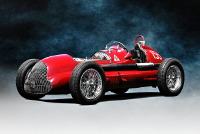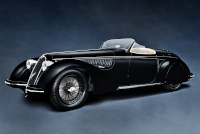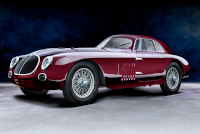Location:
Radnor Hunt Concours d'Elegance, 2007
Owner: David L. George | Cochranville, Pennsylvania
Prologue:
A car that underscores connections between South America and Italy, the Volpi Monoposto is an Argentine product. The car is part of Fangio's domestic racing career prior to the Peronist government that supports his transition to Formula One competition in Europe. As stock American components would be more readily available, (and also developed by Volpi into racing specials for Fangio), classic Alfa Romeo mechanicals would seem truly exotic in comparison. Light weight and high revs would be an advantage over anything off-the-shelf American. (And nothing so proven as a Miller unit built for Indianapolis would have migrated south.) So in this application a 6C Alfa is a formidable competition device.
Search for photographs of the Volpi Monoposto and most depict the car in motion, particularly at the Pittsburgh Vintage Grand Prix at Schenley Park. Our few perspectives here take advantage of a rare static display, one with rare afternoon light at what is the first major concours where I used digital equipment. Mostly photographing landscapes and nocturnal vignettes, I preferred film, and earlier began shooting automobiles using low-ISO Velvia just the same. Interesting days...
- - - - - - - - - -
► Image Source: Nikon D200 (10.2 MP)
References:
Conrado Volpi built racing specials in Argentina, basing his creations on the running gear of both American and European machinery, matched to a simple monoposto design. Volpi created this Alfa Romeo special for Juan Manuel Fangio; with it, Fangio competed in the Argentinian equivalent of the national championship. In his native country, Fangio perfected his craft, racing nearly anything that was fast and four-wheeled. By 1951, he would win the first of his five Formula 1 World Championship titles. Thus, we look back on early racing cars like this 6C special as representative of the grass-roots enterprise that built one of the world's most successful racing drivers.
Fangio gifted this 6C Volpi monoposto to friend and fellow racing driver, Alberto Crespo. In 1950, Crespo won an Argentine National Championship in the Fuerza Limitada class.
For a long while after the curtain closed on the golden age of motor racing, the Museo Juan Manuel Fangio kept this 6C in Balcarce. Not suited to static display, the well known restoration workshop of David L. George revitalized the car for racing, and today this Volpi monoposto is more likely to be seen in motion on the track than it is at rest on a concours lawn.
The internals are derived from the 2.5 litre Tipo 256 platform, a larger, triple-carbureted version of the earlier 6C 2300 whose development began in 1934. So the Volpi special is a rare 6-cylinder monoposto, whereas Alfa works racers typically relied on the straight-8.
Motor: 2,443 cc straight 6-cyinder, cast iron block, alloy hemi-head
Valvetrain: DOHC, 2 valves per cylinder, gear-driven via the front of the motor
Aspiration: tri-carb, naturally aspirated
Power: approximately 125 bhp at 4,750 rpm
Drivetrain: 4-speed gearbox, rear-wheel drive
Etymology:
'6C' identifies that the motor is an inline 6-cylinder, and I use the plain 6C designation here in keeping with Alfa Romeo's nomenclature, even though the factory did not put these pieces together in this configuration. 'Monoposto' refers to the single-seat racing design, along with a nod to Conrado Volpi in order to underscore that this is a classic Argentinian racing car.
Figures:
Conrado Volpi built many unique racing specials, the total number I do not know; this car is unique.
Almost Alfetta: Similarities between the Volpi Special and 158/159
At first glance something from the Alfetta 158/159 family, the short chassis and high-boy stance separate this special from the factory Alfas. Its scale appears almost like a period Maserati, though without the smaller manufacturer's diminutive stature. The grille also identifies the car immediately, typical of Alfa racing specials circa 1940. And more's to be said about the motor, which creates an aviation-spired fuselage illusion when focused absent of the wheels.
Open Mouth: Grille Design on Alfa Romeo Racing Specials
The body of this Argentine special bears a slight heaviness in the front, where the nose might have been more slender. The difficulty lies in crafting the grille, which in this case is oversized for the body. Whereas in Milan the Alfa Romeo factory had at its disposal the top casting and coachwork resources in the world, Volpi's small concern was removed from this level of industrial sophistication. Much of the car uses Alfa Romeo parts, but the body would have been crafted by eye, its shape guided by necessity. For this reason, various Volpi specials portray a similar bullishness in the nose, whether the internals were provided by Alfa Romeo, Cadillac, or Chevrolet. For comparison, look up the Alfa Romeo 159 Alfetta.
Of note, the two 8C 2900B Mille Miglia cars rebodied after incident demonstate a similar wide-mouth fascia. (Both are now part of the Schlumpf collection.) By 1940, the pattern had become popular, a means to incorporate streamlining into the steel grille as if it were a part of the body—less classically inspired, but sensible.
Paint Craft: Hand-Painted Details on the Volpi Special
Among the car's smaller details are the various hand-painted notations. On the intake side—not visible in these photos—a crudely painted Argentinian flag sits above the white-lettered names, J. Fangio and A. Crespo. A short ways below is the indication, "Costru. C. Volpi." Also on the intake side, low on the nose, is the indication, "2500 CC," which would have identified the competition class in period. Visible in these exhaust-side images is the traditional Alfa Romeo clover, the Quadrifoglio. An insignia of the factory racing program, Alfa Corse, the Quadrifolio seems as much a personal addition to racing Alfas as it was a team emblem—something added by choice, and therefore not out of place on an Alfa Romeo built in Argentina.
Last Updated: Mar 26, 2025






